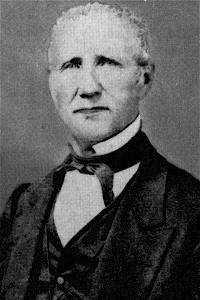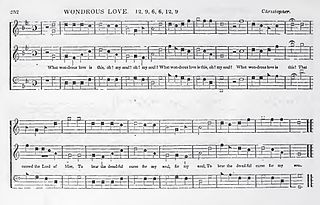
Shape notes are a musical notation designed to facilitate congregational and social singing. The notation, introduced in late 18th century England, became a popular teaching device in American singing schools. Shapes were added to the noteheads in written music to help singers find pitches within major and minor scales without the use of more complex information found in key signatures on the staff.

A hymnal or hymnary is a collection of hymns, usually in the form of a book, called a hymnbook. They are used in congregational singing. A hymnal may contain only hymn texts ; written melodies are extra, and more recently harmony parts have also been provided.

Sacred Harp singing is a tradition of sacred choral music that originated in New England and was later perpetuated and carried on in the American South. The name is derived from The Sacred Harp, a ubiquitous and historically important tunebook printed in shape notes. The work was first published in 1844 and has reappeared in multiple editions ever since. Sacred Harp music represents one branch of an older tradition of American music that developed over the period 1770 to 1820 from roots in New England, with a significant, related development under the influence of "revival" services around the 1840s. This music was included in, and became profoundly associated with, books using the shape note style of notation popular in America in the 18th and early 19th centuries.
A singing school is a school in which students are taught to sightread vocal music. Singing schools are a long-standing cultural institution in the Southern United States. While some singing schools are offered for credit, most are informal programs.

The Southern Harmony, and Musical Companion is a shape note hymn and tune book compiled by William Walker, first published in 1835. The book is notable for having originated or popularized several hymn tunes found in modern hymnals and shape note collections like The Sacred Harp.

William Walker was an American Baptist song leader, shape note "singing master", and compiler of four shape note tunebooks, most notable of which are the influential The Southern Harmony and The Christian Harmony, which has been in continuous use.

Benjamin Franklin White was a shape note "singing master", and compiler of the shape note tunebook known as The Sacred Harp. He was born near Cross Keys in Union County, South Carolina, the twelfth child of Robert and Mildred White.
James Landrum White was a shape note singing teacher, composer, and a reviser of his father's shape note tunebook known as The Sacred Harp.
Joseph Stephen James, of Douglasville, Georgia, was a lawyer, community leader, shape note singer, composer, and a reviser of the tunebook known as The Sacred Harp.
The Christian Harmony is a shape note hymn and tune book compiled by William Walker. The book was released in 1866. It is part of the larger tradition of shape note singing.
The New Harp of Columbia is a seven-shape shape note tune book first published in 1867 in Knoxville, Tennessee by Marcus Lafayette Swan. A successor to The Harp of Columbia published by Swan and his father, W.H. Swan, in 1848, The New Harp includes a mixture of hymn tunes, folk hymns, fuguing pieces, and anthems, along with several of Swan's original compositions. The book maintains popularity in East Tennessee, with about 20 singings in 2004.

Ananias Davisson was a singing school teacher, printer and compiler of shape note tunebooks. He is best known for his 1816 compilation Kentucky Harmony, which is the first Southern shape-note tunebook. According to musicologist George Pullen Jackson, Davisson's compilations are "pioneer repositories of a sort of song that the rural South really liked."
The Kentucky Harmony is a shape note tunebook, published in 1816 by Ananias Davisson. It is the first Southern shape-note tunebook.
James P. Carrell , of Lebanon, Virginia, was a minister, singing teacher, composer and songbook compiler. He compiled two songbooks in the four-shape shape note tradition.
The Southwest Texas Sacred Harp Singing Convention is an annual gathering of shape note singers. Songs are sung a cappella from the Sacred Harp tune book. The convention was organized on April 28, 1900, at the Round Top School House, in Caldwell County, Texas, as the South Union Singing Convention. It is the second oldest continuous Sacred Harp convention in Texas. Several older conventions are no longer extant.
William Clarke Hauser was an American minister, medical doctor, teacher, composer, and music publisher.
The Sacred Harp is a shape note tunebook, originally compiled in 1844 by Benjamin Franklin White and Elisha J. King in Georgia and used to this day in revised form by Sacred Harp singers throughout America and overseas. This article is a historical overview and listing of the composers and poets who wrote the songs and texts of The Sacred Harp.

"What Wondrous Love Is This" is a Christian folk hymn from the American South. Its text was first published in 1811, during the Second Great Awakening, and its melody derived from a popular English ballad. Today it is a widely known hymn included in hymnals of many Christian denominations.

The Shenandoah Harmony is a 2013 republication of the works of Ananias Davisson (1780–1857) and other composers of his era, in the format used by modern shape note singing groups. Although a number of new shape note tune books were compiled and published in the two decades leading up to the publication of the Shenandoah Harmony, this volume is notable as "the largest new four-shape tunebook published for more than 150 years." The book is named after Shenandoah Valley, whose importance in the emergence of a distinctive Southern shape-note singing tradition has been noted by many musicologists. Authentic South reporter Kelley Libby of WFAE, attending an all-day singing in Cross Keys, felt "transported to the Shenandoah Valley of the 1800s."








